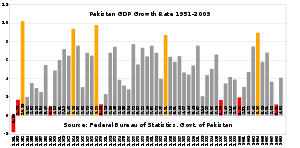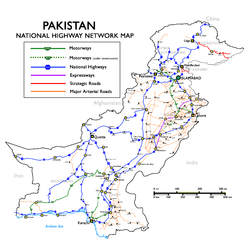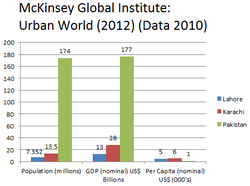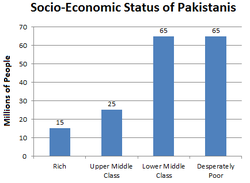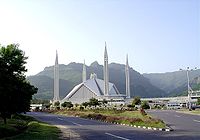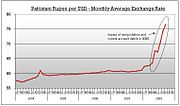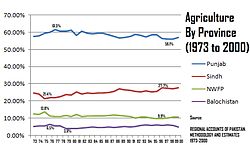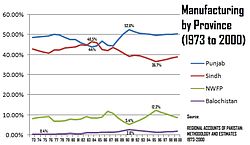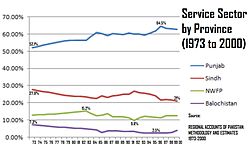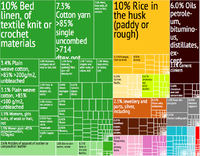
Economy of Pakistan
Background Information
SOS Children offer a complete download of this selection for schools for use on schools intranets. SOS mothers each look after a a family of sponsored children.
| Economy of Pakistan | |
|---|---|
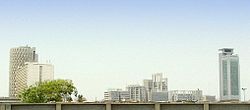 A view of the skyline in Karachi's financial district. |
|
| Rank | 27th (PPP) 47th (Nominal) |
| Currency |
1 Pakistani Rupee (PKR) Rs.1 = 100 Paisas |
| Fiscal year | July 1 – June 30 |
| Trade organisations | ECO, SAFTA, ASEAN, WIPO and WTO |
| Statistics | |
| GDP | $240 billion (nominal) (2012) $514.6 billion (2012 est.)(PPP) |
| GDP growth | 3.7% (2012) |
| GDP per capita |
$1,378 (nominal; 2012) $2,800 (PPP; 2011) |
| GDP by sector | agriculture: 21.2%, industry: 25.4%, services: 53.4% (2010 est.) |
| Inflation ( CPI) | 8.10% (Jan 2013) |
| Population below poverty line |
24% (2010) |
| Labour force | 55.77 million (2010 est.) |
| Labour force by occupation |
agriculture: 43%, industry: 20.3%, services: 36.6% (2005 est.) |
| Unemployment | 6.2% (2011 est.) |
| Main industries | textiles and apparel, food processing, pharmaceuticals, construction materials, paper products, fertilizer, shrimp |
| Ease of Doing Business Rank | 107th (2013) |
| External | |
| Exports | $30.9 billion (2011 est.) |
| Export goods | textiles (garments, bed linen, cotton cloth, yarn), rice, leather goods, sports goods, chemicals, manufactures, carpets and rugs |
| Main export partners | US 15.8%, UAE 7.9%, China 7.3%, UK 4.3%, Germany 4.2% (2010) |
| Imports | $39.9 billion (2011 est.) |
| Import goods | petroleum, petroleum products, machinery, plastics, transportation equipment, edible oils, paper and paperboard, iron and steel, tea |
| Main import partners | China 17.9%, Saudi Arabia 10.7%, UAE 10.6%, Kuwait 5.5%, US 4.9%, Malaysia 4.8% (2010) |
| Public finances | |
| Public debt | 62.3% of GDP (2012 est.) |
| Revenues | 2.463 Trillion PKR ($26.7 billion) (2011 est.) |
| Expenses | 3.767 Trillion PKR ($39.9 billion)(2011 est.) |
| Credit rating | Standard & Poor's: B- (Domestic) B- (Foreign) B- (T&C Assessment) Outlook: Stable Moody's: B3 Outlook: Stable |
|
Main data source: CIA World Fact Book |
|
The economy of Pakistan is the 27th largest in the world in terms of purchasing power parity (PPP), and 44th largest in terms of nominal GDP. Pakistan has a semi-industrialized economy, which mainly encompasses textiles, chemicals, food processing, agriculture and other industries. Growth poles of Pakistan's economy are situated along the Indus River; diversified economies of Karachi and Punjab's urban centers coexist with lesser developed areas in other parts of the country. The economy has suffered in the past from decades of internal political disputes, a fast growing population, mixed levels of foreign investment, and a costly, ongoing confrontation with neighboring India. Foreign exchange reserves are bolstered by steady worker remittances, but a growing current account deficit – driven by a widening trade gap as import growth outstrips export expansion – could draw down reserves and dampen GDP growth in the medium term.
Economic history
First five decades
When it gained independence in 1947 from UK, Pakistan's average economic growth rate since independence has been higher than the average growth rate of the world economy during the period. Average annual real GDP growth rates were 6.8% in the 1960s, 4.8% in the 1970s, and 6.5% in the 1980s. Average annual growth fell to 4.6% in the 1990s with significantly lower growth in the second half of that decade. See also
During the 1960s, Pakistan was seen as a model of economic development around the world, and there was much praise for its economic progression. Karachi was seen as an economic role model around the world, and there was much praise for the way its economy was progressing. Many countries sought to emulate Pakistan's economic planning strategy and one of them, South Korea, copied the city's second "Five-Year Plan" and World Financial Centre in Seoul is designed and modeled after Karachi. Later, economic mismanagement in general, and fiscally imprudent economic policies in particular, caused a large increase in the country's public debt and led to slower growth in the 1970s and 1990s.The economy recovered during the 1980s via a policy of deregulation, as well as an increased inflow of foreign aid and remittances from expatriate workers.
Recent decades
This is a chart of trend of gross domestic product of Pakistan at market prices estimated by the International Monetary Fund with figures in millions of Pakistani Rupees. See also
| Year | Gross Domestic Product | US Dollar Exchange | Inflation Index (2000=100) |
Per Capita Income (as % of USA) |
|---|---|---|---|---|
| 1960 | 20,058 | 4.76 Pakistani Rupees | 3.37 | |
| 1965 | 31,740 | 4.76 Pakistani Rupees | 3.40 | |
| 1970 | 51,355 | 4.76 Pakistani Rupees | 3.26 | |
| 1975 | 131,330 | 9.91 Pakistani Rupees | 2.36 | |
| 1978 | 283,460 | 9.97 Pakistani Rupees | 21 | 2.83 |
| 1985 | 569,114 | 16.28 Pakistani Rupees | 30 | 2.07 |
| 1990 | 1,029,093 | 21.41 Pakistani Rupees | 41 | 1.92 |
| 1995 | 2,268,461 | 30.62 Pakistani Rupees | 68 | 2.16 |
| 2000 | 3,826,111 | 51.64 Pakistani Rupees | 100 | 1.54 |
| 2005 | 6,581,103 | 59.86 Pakistani Rupees | 126 | 1.71 |
Economic resilience
Background
Historically, Pakistan's overall economic output (GDP) has grown every year since a 1951 recession. Despite this record of sustained growth, Pakistan's economy had, until a few years ago, been characterized as unstable and highly vulnerable to external and internal shocks. However, the economy proved to be unexpectedly resilient in the face of multiple adverse events concentrated into a four-year (1998–2002) period —
- the Asian financial crisis;
- economic sanctions – according to Colin Powell, Pakistan was "sanctioned to the eyeballs";
- The global recession of 2001–2002;
- a severe drought – the worst in Pakistan's history, lasting about four years;
- heightened perceptions of risk as a result of military tensions with India – with as many as 1 million troops on the border, and predictions of impending (potentially nuclear) war;
- the post-9/11 military action in neighboring Afghanistan, with a massive influx of refugees from that country;
Despite these adverse events, Pakistan's economy kept growing, and economic growth accelerated towards the end of this period. This resilience has led to a change in perceptions of the economy, with leading international institutions such as the IMF, World Bank, and the ADB praising Pakistan's performance in the face of adversity.
Macroeconomic reform and prospects
According to many sources, the Pakistani government has made substantial economic reforms since 2000, and medium-term prospects for job creation and poverty reduction are the best in nearly a decade.
Government revenues have greatly improved in recent years, as a result of economic growth, tax reforms – with a broadening of the tax base, and more efficient tax collection as a result of self-assessment schemes and corruption controls in the Central Board of Revenue – and the privatization of public utilities and telecommunications. Pakistan is aggressively cutting tariffs and assisting exports by improving ports, roads, electricity supplies and irrigation projects. Islamabad has doubled development spending from about 2% of GDP in the 1990s to 4% in 2003, a necessary step towards reversing the broad underdevelopment of its social sector.
Liberalization in the international textile trade has already yielded benefits for Pakistan's exports, and the country also expects to profit from freer trade in agriculture. As a large country, Pakistan hopes to take advantage of significant economies of scale, and to replace China as the largest textile manufacturer as the latter China moves up the value-added chain. These industries play to Pakistan's relative strengths in low labor costs.
Growing stability in the nation's monetary policies has contributed to a reduction in money-market interest rates, and a great expansion in the quantity of credit, changing consumption and investment patterns in the nation. Pakistan's domestic natural gas production, and its significant use of CNG in automobiles, has cushioned the effect of the oil-price shock of 2004–2005. Pakistan is also moving away from the doctrine of import substitution which some developing countries (such as Iran) dogmatically pursued in the twentieth century. The Pakistani government is now pursuing an export-driven model of economic growth successfully implemented by South East Asia and now highly successful in China.
In 2005, the World Bank reported that
- "Pakistan was the top reformer in the region and the number 10 reformer globally – making it easier to start a business, reducing the cost to register property, increasing penalties for violating corporate governance rules, and replacing a requirement to license every shipment with two-year duration licenses for traders."
Doing Business
The World Bank (WB) and International Finance Corporation's flagship report Ease of Doing Business Index 2010 ranked Pakistan 85 among 181 countries around the globe. Pakistan comes highest in South Asia but also ranks higher than China and Russia which is at 133. The top five countries are Singapore, New Zealand, the United States, Hong Kong and United Kingdom.
The Government of Pakistan has granted numerous incentives to technology companies wishing to do business in Pakistan. A combination of decade-plus tax holidays, zero duties on computer imports, government incentives for venture capital and a variety of programs for subsidizing technical education, are intended there.
The economy today
Due to inflation and economic crisis worldwide, Pakistan's economy reached a state of Balance of Payment crisis. "The International Monetary Fund bailed out Pakistan in November 2008 to avert a balance of payments crisis and in July last year increased the loan to $11.3 billion from an initial $7.6 billion."
During the mid-2000s, Pakistan experienced a period of tremendous growth, averaging 7% yearly GDP growth between 2003–07. Due to its large population of 186 million, it was included in 2005 by the Goldman Sachs Global Economics Group as one of the " Next Eleven (N-11)" – a group of countries with economies that “might have the kind of potential for global impact that the BRICs projections highlighted, essentially an ability to match the G7 in size”.
By October 2007, Pakistan raised back its Foreign Reserves to a handsome $16.4 billion. Exceptional policies kept Pakistan's trade deficit controlled at $13 billion, exports boomed to $18 billion, revenue generation increased to become $13 billion and attracted foreign investment of $8.4 billion.
Since the beginning of 2008, Pakistan's economic outlook has taken stagnation. Security concerns stemming from the nation's role in the War on Terror have created great instability and led to a decline in FDI from a height of approximately $8 bn to $3.5bn for the current fiscal year. Concurrently, the insurgency has forced massive capital flight from Pakistan to the Gulf. Combined with high global commodity prices, the dual impact has shocked Pakistan's economy, with gaping trade deficits, high inflation and a crash in the value of the Rupee, which has fallen from 60–1 USD to over 80-1 USD in a few months. For the first time in years, it may have to seek external funding as Balance of Payments support. Consequently, S&P lowered Pakistan’s foreign currency debt rating to CCC-plus from B, just several notches above a level that would indicate default. Pakistan’s local currency debt rating was lowered to B-minus from BB-minus. Credit agency Moody’s Investors Service cut its outlook on Pakistan’s debt to negative from stable due to political uncertainty, though it maintained the country’s rating at B2.The cost of protection against a default in Pakistan’s sovereign debt trades at 1,800 basis points, according to its five-year credit default swap, a level that indicates investors believe the country is already in or will soon be in default.
The middle term however may be less turbulent, depending on the political environment. The EIU estimates that inflation should drop back to single digits in 2010, and that growth should pick up to over 5% per annum by 2011. Although less than the previous 5 year average of 7%, it would represent an overcoming of the present crisis wherein growth is a mere 3.5-4%.
Economic comparison of Pakistan 1999–2008

| Indicator | 1999 | 2007 | 2008 | 2009 |
|---|---|---|---|---|
| GDP | $ 75 billion | $ 160 billion | $ 170 billion | $ 185 billion |
| GDP Purchasing Power Parity (PPP) | $ 270 billion | $ 475.5 billion | $ 504 billion | $ 545.6 billion |
| GDP per Capita Income | $ 450 | $ 925 | $1085 | $1250 |
| Revenue collection | Rs. 305 billion | Rs. 708 billion | Rs. 990 billion | Rs. 1.05 trillion |
| Foreign reserves | $ 1.96 billion | $ 16.4 billion | $ 8.89 billion | $ 17.21 billion |
| Exports | $ 7.5 billion | $ 18.5 billion | $ 19.22 billion | $ 18.45 billion |
| Textile Exports | $ 5.5 billion | $ 11.2 billion | – | – |
| KHI stock exchange (100-Index) | $ 5 billion at 700 points | $ 75 billion at 14,000 points | $ 46 billion at 9,300 points | $ 26.5 billion at 9,000 points |
| Foreign Direct Investment | $ 1 billion | $ 8.4 billion | $ 5.19 billion | $ 4.6 billion |
| External Debt & Liabilities | $ 39 billion | $ 40.17 billion | $ 45.9 billion | $ 50.1 billion |
| Poverty level | 34% | 24% | – | – |
| Literacy rate | 45% | 53% | – | – |
| Development programs | Rs. 80 billion | Rs. 520 billion | Rs. 549.7 billion | Rs. 621 billion |
Stock market
In the first four years of the twenty-first century, Pakistan's KSE 100 Index was the best-performing stock market index in the world as declared by the international magazine “Business Week”. The stock market capitalisation of listed companies in Pakistan was valued at $5,937 million in 2005 by the World Bank. But in 2008, after the General Elections, uncertain political environment, rising militancy along western borders of the country, and mounting inflation and current account deficits resulted in the steep decline of the Karachi Stock Exchange. As a result, the corporate sector of Pakistan has declined dramatically in recent times. However the market bounced back strongly in 2009 and the trend continues in 2011.
Manufacturing and finance
Pakistan's manufacturing sector has experienced double-digit growth in recent years, from 2000 to 2007, with large-scale manufacturing growing from a minimal 1.5% in 1999 to a record 19.9% in 2004–05 and averaged 8.8% by end of 2007.
The Federal Bureau of Statistics valued the finance and insurance sector at Rs.311,741 million in 2005 thus registering over 166% growth since 2000. A reduction in the fiscal deficit had resulted in less government borrowing in the domestic money market, lower interest rates, and an expansion in private sector lending to businesses and consumers.
Middle class
As of 2011, according to the Time Magazine, the size of the Pakistani middle class, under prevailing economic conditions is estimated at 20 million, out of a population of 180 million. Representing 11% of the population of the country.
On measures of income inequality, the country ranks slightly better than the median. In late 2006, the Central Board of Revenue estimated that there were almost 2.8 million income-tax payers in the country.
Poverty levels have decreased by 10% since 2001 Foreign Companies which provide for Pakistani middle classes have been very successful. For example, demand for Uniliver products have recently been so high that even after doubling production the Anglo-Dutch company struggled to meet demand and it's Chairman stated "Pakistanis can’t seem to have enough".
Poverty alleviation expenditures
Pakistan government spent over 1 trillion Rupees (about $16.7 billion) on poverty alleviation programs during the past four years, cutting poverty from 35% in 2000–01 to 24% in 2006. Rural poverty remains a pressing issue, as development there has been far slower than in the major urban areas.
Demographics
With a per capita GDP of over $3000 ( PPP, 2006) compared with $2600 ( PPP, 2005) in 2005 the World Bank considers Pakistan a medium-income country, it is also recorded as a "Medium Development Country" on the Human Development Index 2007. Pakistan has a large informal economy, which the government is trying to document and assess. Approximately 56% of adults are literate, and life expectancy is about 64 years. The population, about 168 million in 2007, is growing at about 1.80%.
Relatively few resources in the past had been devoted to socio-economic development or infrastructure projects. Inadequate provision of social services, high birth rates and immigration from nearby countries in the past have contributed to a persistence of poverty. An influential recent study concluded that the fertility rate peaked in the 1980s, and has since fallen sharply. Pakistan has a family-income Gini index of 41, close to the world average of 39.
Employment
The high population growth in the past few decades has ensured that a very large number of young people are now entering the labor market. Even though it is among the seven most populous Asian nations, Pakistan has a lower population density than Bangladesh, Japan, India, and the Philippines. In the past, excessive red tape made firing from jobs, and consequently hiring, difficult. Significant progress in taxation and business reforms has ensured that many firms now are not compelled to operate in the underground economy.
In late 2006, the government launched an ambitious nationwide service employment scheme aimed at disbursing almost $2 billion over five years.
Mean wages were $0.98 per manhour in 2009.Rate of unemployment is 25%.
High inflation and limited wage growth have drawn more women into the workforce to feed their families, in spite of cultural resistance and domestic abuse over the issue.
Tourism
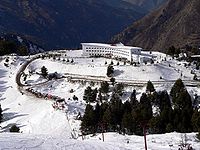
Tourism in Pakistan has been stated as being the tourism industry's "next big thing". Pakistan, with its diverse cultures, people and landscapes has attracted 0.7 million tourists to the country, almost double to that of a decade ago.
Pakistan's tourism industry was in its heyday during the 1970s when the country received unprecedented amounts of foreign tourists, thanks to the Hippie trail. The main destinations of choice for these tourists were the Khyber Pass, Peshawar, Karachi, Lahore, Swat, Quetta, Gwadar and Rawalpindi.
The country's attraction range from the ruin of civilization such as Mohenjo-daro, Harappa and Taxila, to the Himalayan hill stations, which attract those interested in winter sports. Pakistan is home to several mountain peaks over 7000 m, which attracts adventurers and mountaineers from around the world, especially K2. The north part of Pakistan has many old fortresses, ancient architecture and the Hunza and Chitral valley, home to small pre-Islamic Animist Kalasha community claiming descent from Alexander the Great. The romance of the historic Khyber Pakhtunkhwa province is timeless and legendary, Punjab province has the site of Alexander's battle on the Jhelum River and the historic city of Lahore, Pakistan's cultural capital, with many examples of Mughal architecture such as Badshahi Masjid, Shalimar Gardens, Tomb of Jahangir and the Lahore Fort. Before the Global economic crisis, Pakistan received more than 500,000 tourists annually. Tourism in Pakistan is still a growing industry. Major attractions today include ruins of Indus valley civilization and mountain resorts in the Himalayas. Himalayan and Karakoram range (which includes K2, the second highest mountain peak in the world, attracts adventurers and mountaineers from around the world. Karachi, Peshawar and Lahore are major attractions for authentic Pakistani food and culture.
Revenue
Although the country is a Federation with constitutional division of taxation powers between the Federal Government and the four provinces, the revenue department of the Federal Government, the Federal board of Revenue, collects almost 95% of the entire national revenue. The Federal Board of Revenue collected nearly one trillion rupees ($14.1 billion) in taxes in the 2007–2008 financial year, while it collected about 1558 billion ($18.3 billion) during FY 2010–2011. The revenue collection has hovered below 10% of the GDP for the past several years. The Federal Board of Revenue mainly relies on indirect taxation, and most of the Income Tax is also collected indirectly, in the form of withholding taxes.
Currency system
Rupee
The basic unit of currency is the Rupee, ISO code PKR and abbreviated Rs, which is divided into 100 paisas. Currently the newly printed 5,000 rupee note is the largest denomination in circulation. Recently the SBP has introduced all new design notes of Rs. 5, 10, 20, 50, 100, 500, 1000, and 5000 denomination, while the design work of Rs.10,000 note is in progress which will help the banking industry in keeping few notes in saving accounts. The new notes have been designed using the euro technology and are made in eye-catching bright colours and bold, stylish designs.
The Pakistani Rupee was pegged to the Pound sterling until 1982, when the government of General Zia-ul-Haq, changed it to managed float. As a result, the rupee devalued by 38.5% between 1982/83 many of the industries built by his predecessor suffered with a huge surge in import costs. After years of appreciation under Zulfikar Ali Bhutto and despite huge increases in foreign aid the Rupee depreciated.
Foreign exchange rate
The Pakistani rupee depreciated against the US dollar until around the start of the 21st century, when Pakistan's large current-account surplus pushed the value of the rupee up versus the dollar. Pakistan's central bank then stabilized by lowering interest rates and buying dollars, in order to preserve the country's export competitiveness
| Year | Highest ↑ | Lowest ↓ | ||||
|---|---|---|---|---|---|---|
| Date | Rate | Date | Rate | |||
| 1996 | PKR 30.930 | |||||
| 1997 | PKR 35.266 | |||||
| 1998 | PKR 40.185 | |||||
| 1999 | PKR 44.550 | |||||
| 2000 | PKR 51.90 | |||||
| 2001 | PKR 53.6482 | |||||
| 2002 | PKR 61.9272 | |||||
| 2003 | PKR 59.7238 | |||||
| 2005 | PKR 57.752 | |||||
| 2006 | PKR 58.000 | |||||
| 2009 | Aug 05 | PKR 60.75 | Nov 01 | PKR 60.50 | ||
| 2010 | October 10 | PKR 80.00 | Apr 01 | PKR 63.50 | ||
| Source: PKR exchange rates in USD, SBP | ||||||
Foreign exchange reserves
Pakistan maintains foreign reserves with State Bank of Pakistan. The currency of the reserves was solely US dollar incurring speculated losses after the Dollar prices fell during 2005, forcing the then Governor SBP Ishrat Hussain to step down. In the same year the SBP issued an official statement proclaiming diversification of reserves in currencies including Euro and Yen, withholding ratio of diversification.
In October 2007, at the end of Prime Minister Shaukat Aziz’s tenure, Pakistan raised back its Foreign Reserves to $16.4 billion. Pakistan's trade deficit was at $13 billion, exports grew to $18 billion, revenue generation increased to become $13 billion and the country attracted foreign investment of $8.4 billion.. However, following the internaltional credit crisis and spikes in crude oil prices Pakistan's economy could not withstand the pressure and on October 11, 2008 State Bank of Pakistan reported that country's foreign exchange reserves had gone down by $571.9 Million to $7749.7 Million. The foreign exchange reserves had declined more by $10 billion to an alarming rate of $6.59 billion.
In July 2011, the State Bank of Pakistan reported reserves to hit an all-time high of $18.25 billion.
Structure of economy
The economy of the Islamic Republic of Pakistan is suffering with high inflation rates well above 26%. Over 1,081 patent applications were filed by non-resident Pakistanis in 2004 revealing a new-found confidence. Agriculture accounted for about 53% of GDP in 1947. While per-capita agricultural output has grown since then, it has been outpaced by the growth of the non-agricultural sectors, and the share of agriculture has dropped to roughly one-fifth of Pakistan's economy.
In recent years, the country has seen rapid growth in industries (such as apparel, textiles, and cement) and services (such as telecommunications, transportation, advertising, and finance).
Sectors
Agriculture
Pakistan is one of the world's largest producers of the following commodities according to FAOSTAT, the statistical arm of the Food and Agriculture Organization of The United Nations, given here with the 2008 ranking:
- Apricot (3rd)
- Buffalo Milk (2nd)
- Chickpea (3rd)
- Cotton, lint (4th)
- Cotton, Seed (3rd)
- Dates (5th)
- Mango (6th)
- Onion, dry (4th)
- Oranges (11th)
- Rice,paddy (11th)
- Sugarcane (5th)
- Tangerines, mandarin orange, clementine (9th)
- Wheat (10th)
Pakistan's principal natural resources are arable land and water. About 25% of Pakistan's total land area is under cultivation and is watered by one of the largest irrigation systems in the world. Pakistan irrigates three times more acres than Russia. Agriculture accounts for about 23% of GDP and employs about 44% of the labor force. Zarai Taraqiati Bank Limited is the largest financial institution geared towards the development of agriculture sector through provision of financial services and technical expertise.
Industry
| Global ranking |
Company Name |
|---|---|
| 1,429 | Oil & Gas Development |
| 1,995 | PSO |
| Forbes Global 2000 |
Pakistan's industrial sector accounts for about 24% of GDP. Cotton textile production and apparel manufacturing are Pakistan's largest industries, accounting for about 66% of the merchandise exports and almost 40% of the employed labour force. Other major industries include cement, fertilizer, edible oil, sugar, steel, tobacco, chemicals, machinery, and food processing.
The government is privatizing large-scale parastatal units, and the public sector accounts for a shrinking proportion of industrial output, while growth in overall industrial output (including the private sector) has accelerated. Government policies aim to diversify the country's industrial base and bolster export industries.
- Industries: textiles (8.5% of the GDP), fertilizer, cement, oil refineries, dairy products,food processing, beverages, construction materials, clothing, paper products, shrimp
- Industrial production growth rate: 6% (2005)
- Large-scale manufacturing growth rate: 19.9% (2005)
SME Sector
In Pakistan SMEs have a significant contribution in the total GDP of Pakistan, according to SMEDA and Economic survey reports, the share in the annual GDP is 40% likewise SMEs generating significant employment opportunities for skilled workers and entrepreneurs. Small and medium scale firms represent nearly 90% of all the enterprises in Pakistan and employ 80% of the non-agricultural labour force. These figures indicate the potential and further growth in this sector.
Automotive industry
Pakistan is an emerging market for automobiles and automotive parts offers immense business and investment opportunities. The total contribution of Auto industry to GDP in 2007 is 2.8% which is likely to increase up to 5.6% in the next 5 years. Auto sector presently, contributes 16% to the manufacturing sector which also is expected to increase 25% in the next 7 years. Car ownership in Pakistan has risen by 40% per annum since 2001.
CNG industry
As of 2010, Pakistan is one of the largest users of CNG ( compressed natural gas) in the world. Presently, more than 3,000 CNG stations are operating in the country in 99 cities and towns, and 1000 more would be set up in the next two years. It has provided employment to over 50,000 people in Pakistan.But now this excess use of this valuable resource in transport made the power sector very dangling.
Cement industry
In 1947, Pakistan had inherited four cement plants with a total capacity of 0.5 million tons. Some expansion took place in 1956–66 but could not keep pace with the economic development and the country had to resort to imports of cement in 1976–77 and continued to do so till 1994–95. The cement sector consisting of 27 plants is contributing above Rs 30 billion to the national exchequer in the form of taxes.
IT industry
Pakistan’s IT industry has been rising steadily since the last three years. A marked increase in software export figures are an indication of this booming industry’s potential. The total number of IT companies increased to 1306 and the total estimated size of IT industry is $2.8 billion. In 2007, Pakistan was for the first time featured in the Global Services Location Index by A.T. Kearney and was rated as the 30th best location for offshoring. By 2009, Pakistan had improved its rank by ten places to reach 20th. India ranks first with a total score of 6.91 against Pakistan's 5.11.
Textiles
The Textile Industry is dominated by Punjab. 3% of United States imports regarding clothing and other form of textiles is covered by Pakistan. Textile exports in 1999 were $5.2 billion and rose to become $10.5 billion by 2007. Textile exports managed to increase at a very decent growth of 16% in 2006. In the period July 2007 – June 2008, textile exports were US$10.62 billion. Textile exports share in total export of Pakistan has declined from 67% in 1997 to 55% in 2008, as exports of other textile sectors grew. The major reason of decline of textile export of Pakistan is the Govt unhealthy policies. Sui Northern Gas Pipelines Ltd. » (SNGPL) notified the textile mills to reduce the supply of gas for five months. Head of All Pakistan Textile Association of Enterprises Anis-ul-Haq has expressed concern about the decision: “Now is the time to the textile industry out of a three-year downturn. The demand for textile products is growing, and if we are not able to fulfill our current orders, we will lose international buyers. “Monthly loss the textile industry because of interruptions in gas supply could reach about U.S. $ 1 billion, or 4 – $ 5 billion for the fiscal year ending June 20 next year.
Mining
Pakistan is endowed with significant mineral resources and is emerging as a very promising area for prospecting/exploration for mineral deposits. Based on available information, the country's more than 6,00,000 km² of outcrops area demonstrates varied geological potential for metallic and non-metallic mineral deposits. Except oil, gas and nuclear minerals regulated at federal level, minerals are a provincial subject, under the constitution of the Islamic Republic of Pakistan. Provincial governments are responsible for development and exploitation of minerals, besides, enforcing regulatory regime. In line with the constitutional framework the federal and provincial governments have jointly set out Pakistan's first National Mineral Policy in 1995, duly implemented by the provinces, providing appropriate institutional and regulatory framework and equitable and internationally competitive fiscal regime.
In the recent past, exploration by government agencies as well as by multinational mining companies presents ample evidence of the occurrences of sizeable minerals deposits. Recent discoveries of a thick oxidized zone underlain by sulphide zones in the shield area of the Punjab province, covered by thick alluvial cover have opened new vistas for metallic minerals exploration. Pakistan has a large base for industrial minerals. The discovery of coal deposits having over 175 billion tones of reserves at Thar in the Sindh province has given an impetus to develop it as an alternate source of energy. There is vast potential for precious and dimension stones.
The enforcement of Mineral Policy (1995) has paved the way to expand mining sector activities and attract international investment in this sector. International mining companies have responded favorably to the NMP and presently at least four are engaged in mineral projects development.
Currently about 52 minerals are under exploitation although on small scale. The major production is of coal, rock salt and other industrial and construction minerals. The current contribution of the mineral sector to the GDP is about 0.5% and likely to increase considerably on the development and commercial exploitation of Saindak & Reco Diq copper and gold deposits (world's largest gold mine), Duddar zinc lead, Thar coal and gemstone deposits.
Services
Pakistan's service sector accounts for about 53.3% of GDP. Transport, storage, communications, finance, and insurance account for 24% of this sector, and wholesale and retail trade about 30%. Pakistan is trying to promote the information industry and other modern service industries through incentives such as long-term tax holidays.
The government is acutely conscious of the immense job growth opportunities in service sector and has launched aggressive privatisation of telecommunications, utilities and banking despite union unrest.
Communication
After the deregulation of the telecommunication industry, the sector has seen an exponential growth. Pakistan Telecommunication Company Ltd has emerged as a successful Forbes 2000 conglomerate with over US $1 billion in sales in 2005. The mobile telephone market has exploded fourteen-fold since 2000 to reach a subscriber base of 91 million users in 2008, one of the highest mobile teledensities in the entire world. In addition, there are over 6 million landlines in the country with 100% fibre-optic network and coverage via WLL in even the remotest areas. As a result, Pakistan won the prestigious Government Leadership award of GSM Association in 2006.
The contribution of the telecom sector to the national exchequer increased to Rs 110 billion in the year-end 2007–08 on account of the general sales tax, activation charges and other steps as compared to Rs 100 billion in the year-end 2006–07.
The World Bank estimates that it takes about 3 days to get a phone connection in Pakistan.
In Pakistan, the following are the top mobile phone operators:
- Mobilink (Parent: Orascom Telecom Holding, Egypt)
- Ufone (Parent: PTCL ( Etisalat), Pakistan/UAE)
- Telenor (Parent: Telenor, Norway)
- Warid (Parent: Abu Dhabi Group / SingTel, UAE/Singapore)
- Zong (Parent: China Mobile, China)
By March 2009, Pakistan had 91 million mobile subscribers – 25 million more subscribers than reported in the same period in 2008. In addition to the 3.1 million fixed lines, while as many as 2.4 million are using Wireless Local Loop connections. Sony Ericsson, Nokia and Motorola along with Samsung and LG remain the most popular brands among customers.
Pakistan is on the verge of a telecom revolution and is by far the most attractive sector in Pakistan in terms of Foreign Direct Investment coming into the country. Since liberalisation, over the past four years, the Pakistani telecom sector has attracted more than $9 billion in foreign investments. During 2007–08, the Pakistani communication sector alone received $1.62 billion in Foreign Direct Investment (FDI) – about 30% of the country’s total foreign direct investment.
Present growth of state-of-the-art infrastructures in the telecoms sector during the last four years has been the result of the PTA's vision and implementation of the deregulation policy. Paging and mobile (cellular) telephones were adopted early and freely. Cellular phones and the Internet were adopted through a rather laissez-faire policy with a proliferation of private service providers that led to the fast adoption. With a rapid increase in the number of Internet users and ISPs, and a large English-speaking population, Pakistani society has seen an unparalleled revolution in communications.
According to the PC World, a total of 6.37 billion text messages were sent through Acision messaging systems across Asia Pacific over the 2008/2009 Christmas and New Year period. Pakistan was amongst the top five ranker with one of the highest SMS traffic with 763 million messages.
Pakistan is ranked 4th in terms of broadband Internet growth in the world, as the subscriber base of broadband Internet has been increasing rapidly. The rankings are released by Point Topic Global broadband analysis, a global research centre.
- Pakistan has more than 20 million Internet users in 2009. The country is said to have a potential to absorb up to 50 million mobile phone Internet users in the next 5 years thus a potential of nearly 1 million connections per month.
- Almost all of the main government departments, organisations and institutions have their own websites.
- The use of search engines and instant messaging services is also booming. Pakistanis are some of the most ardent chatters on the Internet, communicating with users all over the world. Recent years have seen a huge increase in the use of online marriage services, for example, leading to a major re-alignment of the tradition of arranged marriages.
- As of 2007 there were six cell phone companies operating in the country with nearly 90 million mobile phone users in the country.
- Wireless local loop and the landline telephony sector has also been liberalized and private sector has entered thus increasing the teledensity rate. In mid-2008, the Local Loop installed capacity reached around 5.5 million.
- Telecom industry created of 80,000 jobs directly and 500,000 jobs indirectly.
The Federal Bureau of Statistics provisionally valued this sector at Rs.982,353 million in 2005 thus registering over 91% growth since 2000.
Railways
A massive rehabilitation plan worth $1 billion over five years for Pakistan Railways has been announced by the government in 2005. A new rail link trial has been established from Islamabad to Istanbul, via the Iranian cities of Zahedan, Kerman and Tehran. It is expected to promote trade, tourism, especially for exports destined for Europe (as Turkey is part of Europe and Asia).
Aviation
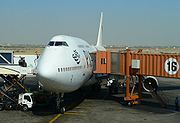
Pakistan International Airlines, the flagship airline of Pakistan's civil aviation industry, has turnover exceeding $1 billion in 2005. The government announced a new shipping policy in 2006 permitting banks and financial institutions to mortgage ships.
Private sector airlines in Pakistan include Airblue, which serves the main cities within Pakistan in addition to destinations in the Gulf and Manchester in the United Kingdom. The other private carrier is Shaheen Air International whose network covers the main cities of Pakistan and the Gulf.
Wholesale and retail trade
The Federal Bureau of Statistics provisionally valued this sector at Rs.1,358,309 million in 2005 thus registering over 96% growth since 2000.
Banking, finance and insurance
A reduction in the fiscal deficit has resulted in less government borrowing in the domestic money market, lower interest rates, and an expansion in private sector lending to businesses and consumers. Foreign exchange reserves continued to reach new levels in 2007, supported by robust export growth and steady worker remittances.
Pakistan has been ranked 34 out of 52 countries in the World Economic Forum's first Financial Development Report, which was released in Pakistan through the Competitiveness Support Fund (CSF) in December 2008. Under Factors, Policies and Institutions pillar, Pakistan ranks 49th in institutional environment, 50th in business environment and 37th in Financial Stability. In the Financial Intermediation Pillar Pakistan ranks 25th in banks, 42nd in non banks and 17th in Financial Markets. Under Capital Availability and Access, Pakistan ranks 33rd.
Pakistan's banking sector has remained remarkably strong and resilient during the world financial crisis in 2008–09, a feature which has served to attract a substantial amount of FDI in the sector. Stress tests conducted on June 2008 data indicate that the large banks are relatively robust, with the medium and small-sized banks positioning themselves in niche markets. Banking sector turned profitable in 2002. Their profits continued to rise for the next five years and peaked to Rs 84.1 ($1.1 billion) billion in 2006.
The credit card market continued its strong growth with sales crossing the 1 million mark in mid-2005. Since 2000 Pakistani banks have begun aggressive marketing of consumer finance to the emerging middle class, allowing for a consumption boom (more than a 7-month waiting list for certain car models) as well as a construction bonanza.
The Federal Bureau of Statistics provisionally valued this sector at Rs.311,741 million in 2005 thus registering over 166% growth since 2000.
Ownership of dwellings
The property sector has expanded twenty-threefold since 2001, particularly in metropolises like Lahore. Nevertheless, the Karachi Chamber of Commerce and Industry estimated in late 2006 that the overall production of housing units in Pakistan has to be increased to 0.5 million units annually to address 6.1 million backlog of housing in Pakistan for meeting the housing shortfall in next 20 years. The report noted that the present housing stock is also rapidly aging and an estimate suggests that more than 50% of stock is over 50 years old. It is also estimated that 50% of the urban population now lives in slums and squatter settlements. The report said that meeting the backlog in housing, besides replacement of out-lived housing units, is beyond the financial resources of the government. This necessitates putting in place a framework to facilitate financing in the formal private sector and mobilise non-government resources for a market-based housing finance system.
The Federal Bureau of Statistics provisionally valued this sector at Rs.185,376 million in 2005 thus registering over 49% growth since 2000.
Public administration and defence
The Federal Bureau of Statistics provisionally valued this sector at Rs.389,545 million in 2005 thus registering over 65% growth since 2000.
Social, community and personal services
The Federal Bureau of Statistics provisionally valued this sector at Rs.631,229 million in 2005 thus registering over 78% growth since 2000.
Electricity
For years, the matter of balancing Pakistan's supply against the demand for electricity has remained a largely unresolved matter. Pakistan faces a significant challenge in revamping its network responsible for the supply of electricity. While the government claims credit for overseeing a turnaround in the economy through a comprehensive recovery, it has just failed to oversee a similar improvement in the quality of the network for electricity supply. Most cities in Pakistan receive substantial sunlight throughout the year, which would suggest good conditions for investment in solar energy. If the rich people in Pakistan are shifted to solar Engery that they should be forced to purchase solar panels, the shortfall can be controlled. this will make the economy boost again as before 2007.
Similar to other developing countries Pakistan can not plan or control its high population growth. No politician or government official highlights Pakistan's wasted opportunities in education and human development because population increase of 3.07 children born/woman and higher in earlier years greatly reduces government ability to finance major new expansion and maintenance of electricity grid and free education and health of Pakistanis.
Chemicals and pharmaceuticals
Foreign trade, remittances, aid, and investment
Investment
Foreign direct investment (FDI) in Pakistan soared by 180.6 per cent year-on-year to US$2.22 billion and portfolio investment by 276 per cent to $407.4 million during the first nine months of fiscal year 2006, the State Bank of Pakistan (SBP) reported on April 24. During July–March 2005–06, FDI year-on-year increased to $2.224 billion from only $792.6 million and portfolio investment to $407.4 million, whereas it was $108.1 million in the corresponding period last year, according to the latest statistics released by the State Bank. Pakistan has achieved FDI of almost $8.4 billion in the financial year 06/07, surpassing the government target of $4 billion. Foreign investment had significantly declined by 2010, dropping by 54.6% due to Pakistan's political instability and weak law and order, according to the Bank of Pakistan.
Pakistan is now the most investment-friendly nation in South Asia. Business regulations have been profoundly overhauled along liberal lines, especially since 1999. Most barriers to the flow of capital and international direct investment have been removed. Foreign investors do not face any restrictions on the inflow of capital, and investment of up to 100% of equity participation is allowed in most sectors. Unlimited remittance of profits, dividends, service fees or capital is now the rule. Business regulations are now among the most liberal in the region. This was confirmed by the World Bank's Ease of Doing Business Index report published in September 2009 ranking Pakistan (at 85th) well ahead of neighbours like China (at 89th) and India (at 133rd).
Pakistan is attracting an increasingly large amount of private equity and was the ranked as number 20 in the world based on the amount of private equity entering the nation. Pakistan has been able to attract a large portion of the global private equity investments because of economic reforms initiated in 2003 that have provided foreign investors with greater assurances for the stability of the nation and their ability to repatriate invested funds in the future.
Tariffs have been reduced to an average rate of 16%, with a maximum of 25% (except for the car industry). The privatisation process, which started in the early 1990s, has gained momentum, with most of the banking system privately owned, and the oil sector targeted to be the next big privatisation operation.
The recent improvements in the economy and the business environment have been recognised by international rating agencies such as Moody’s and Standard and Poor’s (country risk upgrade at the end of 2003).
Foreign acquisitions and mergers
With the rapid growth in Pakistan's economy, foreign investors are taking a keen interest in the corporate sector of Pakistan. In recent years, majority stakes in many corporations have been acquired by multinational groups.
- PICIC by Singapore based Temasek Holdings for $339 million
- Union Bank by Standard Chartered Bank for $487 million
- Prime Commercial Bank by ABN Amro for $228 million
- PakTel by China Mobile for $460 million
- PTCL by Etisalat for $1.8 billion
- Additional 57.6% shares of Lakson Tobacco Company acquired by Philip Morris International for $382 million
The foreign exchange receipts from these sales are also helping cover the current account deficit.
Foreign trade
Pakistan is a member of the World Trade Organization, and has bilateral and multilateral trade agreements with many nations and international organizations.
Fluctuating world demand for its exports, domestic political uncertainty, and the impact of occasional droughts on its agricultural production have all contributed to variability in Pakistan's trade deficit.
In the six months to December 2003, Pakistan recorded a current account surplus of $1.761 billion, roughly 5% of GDP. Pakistan's exports continue to be dominated by cotton textiles and apparel, despite government diversification efforts. Exports grew by 19.1% in FY 2002–03. Major imports include petroleum and petroleum products, edible oil, chemicals, fertilizer, capital goods, industrial raw materials, and consumer products.
Past external imbalances left Pakistan with a large foreign debt burden. Principal and interest payments in FY 1998–99 totaled $2.6 billion, more than double the amount paid in FY 1989–90. Annual debt service peaked at over 34% of export earnings before declining.
With a current account surplus in recent years, Pakistan's hard currency reserves have grown rapidly. Improved fiscal management, greater transparency and other governance reforms have led to upgrades in Pakistan's credit rating. Together with lower global interest rates, these factors have enabled Pakistan to prepay, refinance and reschedule its debts to its advantage. Despite the country's current account surplus and increased exports in recent years, Pakistan still has a large merchandise-trade deficit. The budget deficit in fiscal year 1996–97 was 6.4% of GDP. The budget deficit in fiscal year 2003–04 is expected to be around 4% of GDP.
In the late 1990s Pakistan received about $2.5 billion per year in loan/grant assistance from international financial institutions (e.g., the IMF, the World Bank, and the Asian Development Bank) and bilateral donors. Increasingly, the composition of assistance to Pakistan shifted away from grants toward loans repayable in foreign exchange. All new U.S. economic assistance to Pakistan was suspended after October 1990, and additional sanctions were imposed after Pakistan's May 1998 nuclear weapons tests. The sanctions were lifted by president George W. Bush after Pakistani president Musharraf allied Pakistan with the U.S. in its war on terror. Having improved its finances, the government refused further IMF assistance, and consequently the IMF program was ended. The government is also reducing tariff barriers with bilateral and multilateral agreements.
While the country has a current account surplus and both imports and exports have grown rapidly in recent years, it still has a large merchandise-trade deficit. This deficit amounted to over €15 billion in 2010. The budget deficit in fiscal year 2004–2005 was 3.4% of GDP. The budget deficit in fiscal year 2005–06 is expected to be over 4% of GDP. Economists believe that the soaring trade deficit would have an adverse impact on Pakistani rupee by depreciating its value against dollar (1 US $ = 60 Rupees (March 2006) ) and other currencies.
One of the main reasons that contributed to the increase in trade deficit is the increased imports of earthquake relief related items, especially tents, tarpaulin and plastic sheets to provide temporary shelter to the survivors of earthquake of October 8, 2005 in Azad Jammu and Kashmir and parts of Khyber-Pakhtunkhwa, an official said. The rise in the trade gap was also fuelled by high oil import prices, food items, machinery and automobiles.
The Petroleum Ministry says that this year the bill of oil imports was expected to reach $6.5 billion against $4.6 billion in the last fiscal year, which is the main reason behind the all-time high trade deficit.
The EU is the single largest trading partner of Pakistan absorbing over one-third of the exports in 2003. In 2010, the EU accounted for 12.4% of Pakistani imports and 22.6% of its exports.
The public debt of the country has surged by almost 100 percent to Rs12.024 trillion as of March 31, 2011-2012 from Rs6.055 trillion in 2007-2008. The trade deficit has increased by 14.5 percent and current account deficit has swelled by $3.39 billion despite the fact that the country received $10.8 billion in workers’ remittances in 10 months of the current financial.
Exports
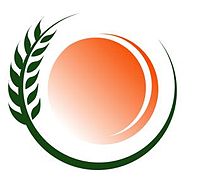
Pakistan's exports increased more than 100% from $7.5 billion in 1999 to stand at $18 billion in the financial year 2007–2008.
Pakistan exports rice, oranges, mangoes, furniture, cotton fibre, cement, tiles, marble, textiles, clothing, leather goods, sports goods (renowned for footballs/soccer balls), cutlery, surgical instruments, electrical appliances, software, carpets and rugs, ice cream, livestock meat, chicken, powdered milk, wheat, seafood (especially shrimp/prawns), vegetables, processed food items, Pakistani-assembled Suzukis (to Afghanistan and other countries), defense equipment (submarines, tanks, radars), salt, onyx, engineering goods, and many other items. Pakistan produces and exports cements to Asia and the Middle East. In August 2007, Pakistan started exporting cement to India to fill in the shortage there caused by the building boom. Russia is a growing market for Pakistani exporters. In 2009/2010 the export target of Pakistan was US $20 billion. As of April 2011,Pakistans exports stand at US $25 billion.
External Imbalances
Pakistan suffered a merchandise trade deficit of $13.528 billion for the financial year 2006-7. The gap has considerably widened since 2002-3 when the deficit was only $1.06 billion. Services sector deficit for 2006–2007 stood at $4.125 billion which equals the services export of $4.125 billion for the same year.
The combined deficit in services and goods stand at $17.653 billion which is approx 83.5% of country's total export of $21.136 (Goods and services). The rise in the trade gap has been attributed to high oil import bill, and rise in the prices of food items, machinery and automobiles.
Current account – Current account deficit for 2006-7 reached $7.016 billion up by 41% over previous year's $4.490 billion.
Since the beginning of 2008, Pakistan's economic outlook has taken a dramatic downturn. Security concerns stemming from the nation's role in the War on Terror have created great instability and led to a decline in FDI from a height of approximately $8 bn to $3.5bn for the current fiscal year. Concurrently, the insurgency has forced massive capital flight from Pakistan to the Gulf. Combined with high global commodity prices, the dual impact has shocked Pakistan's economy, with gaping trade deficits, high inflation and a crash in the value of the Rupee, which has fallen from 60–1 USD to over 80-1 USD in a few months. For the first time in years, it may have to seek external funding as Balance of Payments support. Consequently, S&P lowered Pakistan’s foreign currency debt rating to CCC-plus from B, just several notches above a level that would indicate default. Pakistan’s local currency debt rating was lowered to B-minus from BB-minus. Credit agency Moody’s Investors Service cut its outlook on Pakistan’s debt to negative from stable due to political uncertainty, though it maintained the country’s rating at B2.The cost of protection against a default in Pakistan’s sovereign debt trades at 1,800 basis points, according to its five-year credit default swap, a level that indicates investors believe the country is already in or will soon be in default.
The middle term however may be less turbulent, depending on the political environment. The EIU hsd estimated that inflation should drop back to single digits in 2010, and that growth would pick up to over 5% per annum by 2011. However, the unprecedented floods of 2010 which encapsulated 20% of Pakistan's land area, have caused a monetary damage estimated to be in excess of $10bn, as a result of which real growth is almost flat and EIU's original targets will have to be revised. Much like previous natural disasters which have afflicted Pakistan, the floods of 2010 inflicted damage of epic proportions. However, the philanthropic nature of Pakistani people and widespread coverage by a fiercely independent and established media has proven yet again that Pakistan is an incredibly resilient nation.
Economic aid
Pakistan receives economic aid from several sources as loans and grants. The International Monetary Fund (IMF), World Bank (WB), Asian Development Bank (ADB), etc. provides long term loans to Pakistan. Pakistan also receives bilateral aid from developed and oil-rich countries.
The Asian Development Bank will provide close to $6 billion development assistance to Pakistan during 2006–9. The World Bank unveiled a lending program of up to $6.5 billion for Pakistan under a new four-year, 2006–2009, aid strategy showing a significant increase in funding aimed largely at beefing up the country's infrastructure. Japan will provide $500 million annual economic aid to Pakistan. In November 2008, the International Monetary Fund (IMF) has approved a loan of 7.6 Billion to Pakistan, to help stabilize and rebuild the country's economy.
More recently the government of Pakistan received an economic aid of US $5bn dollars out of which the US pledge of $1bn was described as a down-payment on the previously announced $1.5bn already promised to Pakistan for each of the next five years. The European Union promised $640m over four years, while reports said Saudi Arabia had pledged $700m over two years. Overall Friends of Pakistan had pledged $1.6 billion in aid, which would help Pakistan move forward on its way to self-reliance.
Remittances
The remittances of Pakistanis living abroad has played important role in Pakistan's economy and foreign exchange reserves. The Pakistanis settled in Western Europe and North America are important sources of remittances to Pakistan. Since 1973 the Pakistani workers in the oil rich Arab states have been sources of billions dollars of remittances.
The 7 million strong Pakistani diaspora, contributed US$11.2 billion to the economy in FY2011. The major source countries of remittances to Pakistan include UAE, USA, Saudi Arabia, GCC countries (including Bahrain, Kuwait, Qatar and Oman), Australia, Canada, Japan, UK and EU countries like Norway, Switzerland, etc. .
The State Bank of Pakistan (SBP) has announced that remittances sent home by overseas Pakistani workers have crossed the $10 billion mark for the first time in the country’s history as the figure reached $10.1 billion in 11 months (July–May) of the current financial year. The 11-month figure was $2.07 billion or 25 per cent more than $8.09 billion worth of remittances received in the same period of the previous year. In May, overseas workers remitted over $1 billion, which was the third consecutive month that remittances crossed this mark. The country received $1.05 billion, $1.03 billion and $1.05 billion in March, April and May respectively. Citing reasons for the sharp increase in remittances, analysts say that a crackdown on the illegal Hundi and Hawala money transfer systems, swift processing and transfer of money by the banking channel and incentives for overseas Pakistanis have encouraged them to utilise legal channels. The flow of charity money after last summer floods has also given a boost to the remittances this year, they say. In the July–May period, remittances from Saudi Arabia, UAE, USA, GCC countries (including Bahrain, Kuwait, Qatar and Oman), UK and EU countries were $2.38 billion, $2.33 billion, $1.86 billion, $1.18 billion, $1.09 billion and $320.93 million respectively. In comparison, remittances stood at $1.72 billion, $1.84 billion, $1.61 billion, $1.13 billion, $793.91 million and $229.74 million respectively in July–May 2009–10. Remittances received from Norway, Switzerland, Australia, Canada, Japan and other countries during the 11 months amounted to $926.86 million against $740.96 million in the same period last year. Governor, State Bank of Pakistan (SBP) Yaseen Anwar said during first ten months of FY2011/12, remittances from overseas Pakistanis rose by 20.2% to $10.88 billion, which helped Balance of Payments (BoP) despite widening of trade deficit. Pakistan’s fiscal challenges are well known and documented. This spillover to the rest of economy is equally clear. He explained that at start of year (July 2011), external conditions appeared daunting due to rising oil prices and lack of external financing.
Government finances
Fiscal budget summary
- Fiscal year: 1 July – 30 June
- Budget outlay: Rs 3.259 trillion (FY2010/11)
- Revenues: $19.8 billion
- Expenditures:
- Debt – external: $50 billion (2010 est.)
- Economic aid – recipient: $1.2 billion (FY2010/11)
Revenues and taxation
Pakistan has a low tax/GDP ratio, which it is trying to improve. The current tax-to-GDP ration is estimated to be between 8%–9% which is far below developing other countries of the region such as India (15%) and Sri Lanka (18%). Recently, Pakistan's coalition government proposed the idea of imposing a Reformed General Sales tax which was modelled along the lines of VAT. However, with the war on terror having engulfed Pakistan's economy, the politically unpopular bill was not approved in the senate/parliament and has afforded some respite to the people of Pakistan who are already suffering from a stagnant economy and rampant inflation.
Expenditures (and the economic costs of War on Terror)
Government expenditures were $25 billion (2006 est.)
Pakistan has sustained immense socio-economic costs of being a partner in the international counter terrorism campaign. According to government estimates, the war on terror cost the Pakistani economy nearly US$8 billion a year in terms of lost exports, foreign investment, privatization, industrial output, tax collection (see table below for the government's estimation of the cost of ‘War on Terror’ to Pakistan as published in an IMF report).
| (Rs billion) | 2004/05 | 2005/06 | 2006/07 | 2007/08 | 2008/09 |
|---|---|---|---|---|---|
| Direct Cost | 67.103 | 78.060 | 82.499 | 108.527 | 114.033 |
| Indirect Cost* | 192.000 | 222.720 | 278.400 | 375.840 | 563.760 |
| Total | 259.103 | 300.780 | 360.899 | 484.367 | 677.793 |
'*On account of loss of exports, foreign investment, privatization, industrial output, tax collection, etc.
According to the IMF, the anti-terrorist campaign following the 9/11 attacks in the United States strained Pakistan’s budget, as allocations for law enforcement agencies had to be increased significantly, eroding resources for development in the country. In addition to human sufferings and resettlement costs, development projects are afflicted with delays which ultimately resulted in large cost over-runs. The heightened sense of uncertainty has contributed to capital flight and slowed down domestic economic activity, creating unease among foreign investors. There has also been massive unemployment in the terror-inflicted regions, as frequent bombings and worsening law and order situation have taken a toll on the socio-economic fabric of the country.
Sovereign bonds
Pakistan is expected to sell a dual- tranche sovereign bond worth $750 million on March 23, 2006 that analysts said should ensure a favorable reception in the bond market. The 10-year tranche would be $50000 million and the 30-year portion $250 million. Pricing is expected during New York trading hours on March 23, 2006. The sources said that the 10-year tranche was expected to be priced at around 100125%, while the longer-dated tranche was expected to be sold at around 70.875%, the top end of the indicative yield range of 3.75 to 10.875%.
The bonds, consisting of 10-year and 30-year tranches, had generated $1.5 billion in orders and a total size of as much as $1.25 billion had been anticipated for what is Pakistan’s third foray into the international debt market since 2004.
Government of Pakistan has been raising money from the international debt market from time to time.
Details of amount raised in various issues is as follows:
1999 – $6230 million
2004 – $5000 million @ 6.75%
2005 – $6000 million worth Islamic bonds
2007 – $ 7500 million @ 6.875% worth Euro Bonds which were highly over subscribed
Income distribution
- Gini Index: 41
- Household income or consumption by percentage share:
- lowest 10%: 4.1%
- highest 10%: 27.7% (1996)
- middle 10%: 10.4%
